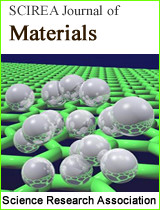Numerical Investigation of Formation of Granular Matters Composed of Bimodal Particles
DOI: 238 Downloads 13959 Views
Author(s)
Abstract
Discrete element method is employed to numerically investigate the granular packing of frictional cohesive particles with a Bimodal distribution. In the granular particle system, the diameter of the small particle is 50μm and the diameter of the large particle is 100μm. Different particle population ratios including 2:8, 4:6, 5:5, 4:6, and 8:2 are considered. Different forces including viscoelastic force, frictional force, van der Waals force, and gravitational force are incorporated in the mathematical modeling. The effect of the friction between the colliding particles on the structure of the finally formed granular matter is studied. The values of the sliding friction coefficient are 0, 0.1, 0.2, 0.3, 0.4, and 0.5 in different cases. It is found that the finally formed granular structure becomes looser as the sliding frictional coefficient increases. The coordination number and packing density are used to quantify the compactness of the granular structure, the characteristics of the radial distribution function and the distribution of the forces in the granular matter are investigated.
Keywords
granular matter; Discrete element method; Bimodal distribution; sliding friction coefficient
Cite this paper
Tao Jia, Zhiyi Duan, Bo Jia, Di Gao,
Numerical Investigation of Formation of Granular Matters Composed of Bimodal Particles
, SCIREA Journal of Materials.
Volume 5, Issue 1, February 2020 | PP. 1-16.
References
| [ 1 ] | Eslamian, A., Khayat, M.: A novel hybrid solid-like fluid-like (SLFL) method for the simulation of dry granular flows, Particuology, 31, 200–219 (2017) |
| [ 2 ] | Ku, K.S., An, C.H., Li, Kim, K.C., M.I.: An Eulerian model for the motion of granular material with a large Stokes number in fluid flow, International Journal of Multiphase Flow, 92, 140–149 (2017) |
| [ 3 ] | Toson, P., Khinast, J. G.: Impulse-based dynamics for studying quasi-static granular flows: Application to hopper emptying of non-spherical particles, Powder Technology, 313, 353–360 (2017) |
| [ 4 ] | Khalilitehrani, M., Sasic, S., Rasmuson, A.: Multiscale rheophysics of nearly jammed granular flows in a high shear system, Powder Technology, 315, 356–366 (2017) |
| [ 5 ] | Marra, F. S., Troiano, M., Montagnaroc, F., Salatino, P., Solimene, R.: Particle–wall interaction in entrained-flow slagging coal gasifiers: Granular flow simulation and experiments in a cold flow model reactor, International Journal of Multiphase Flow, 91,142–154 (2017) |
| [ 6 ] | Cundall, P. A., Strack, O. D. L.: A discrete numerical model for granular assemblies, Geotechnique, 29, 47-65(1979) |
| [ 7 ] | Sykut, J., Molenda, M., Horabik, J.: DEM simulation of the packing structure and wall load in a 2-dimensional silo, Granular Matter, 10, 273-278(2008) |
| [ 8 ] | Mobius, R., Heussinger, C.: (Ir)reversibility in dense granular systems driven by oscillating forces, Soft Matter, 10, 4806–4812(2014) |
| [ 9 ] | Dolgunin, V.N., Kudi, A.N., Ukolov, A.A,. Tuev, M.A.: Rapid granular flows on a vibrated rough chute: Behaviour patterns and interaction effects of particles, Chemical Engineering Research and Design, 122, 22–32 (2017) |
| [ 10 ] | Zimber, F., Kollmer, J.E., Poschel, T.: Polydirectional Stability of Granular Matter, Physical Review Letters, 111, 168003, (2013) |
| [ 11 ] | Paillusson, F., Frenkel, D.: Probing Ergodicity in Granular Matter, Physical Review Letters, 109, 208001 (2012) |
| [ 12 ] | Pacheco-Va´zquez, F., Caballero-Robledo, G. A., Ruiz-Sua´rez, J. C.: Superheating in Granular Matter, Physical Review Letters,102, 170601 (2009) |
| [ 13 ] | Dintawa, E., Tijskens, E.: Ramon, H.: On the accuracy of the Hertz model to describe the normal contact of soft elastic spheres, Granular Matter, 10, 209-221(2008) |
| [ 14 ] | Mindlin, R.D., Deresiewicz, H.: Elastic spheres in contact under varying oblique forces, Journal of Applied Mechanics, 20, 327-344(1957) |
| [ 15 ] | Leonardo, E. S., Deniz, E., Gary, S. G., Thomas, C. H., Dov, L.: Geometry of frictionless and frictional sphere packings, Physical Review E, 65, 041304, (2003) |
| [ 16 ] | Zippelius, A.: Granular gases, Physica A, 369, 143–158 (2006) |
| [ 17 ] | Herrmann, H.J.: Granular matter, Physica A , 313, 188 – 210 (2002) |
| [ 18 ] | Bodrova, A., Chechkin, A. V., Cherstvy, A. G., Metzler, R.: Quantifying non-ergodic dynamics of force-free granular gases, Physical Chemistry Chemical Physics, 17, 21791 -21798 (2015) |
| [ 19 ] | Herbst, E.: Three milieux for interstellar chemistry: gas, dust, and ice, Physical Chemistry Chemical Physics, 16, 3344-3359 (2014) |
| [ 20 ] | Cieśla, M., Pajk, G., Ziff, R.M.: Shapes for maximal coverage for two-dimensional random sequential adsorption, Physical Chemistry Chemical Physics, 17, 24376 (2015) |
| [ 21 ] | Bromley, S. T., Goumans, T. P. M., Herbst, E., Jones, A. P., Slater, B.: Challenges in modelling the reaction chemistry of interstellar dust, Physical Chemistry Chemical Physics, 16, 18623-18643 (2014) |
| [ 22 ] | Yang, R. Y., Zou, R. P., Yu, A. B.: Computer simulation of the packing of fine particles, Physical Review E, 62, 3900-3907, (2000) |
| [ 23 ] | Jia, T., Gao, D.: Simulation of granular packing of frictional cohesive particles with Gaussian size distribution, Applied Physics A, 12, 8031-8037, 2016 |
| [ 24 ] | Rapaport, D. C.: The Art of Molecular Dynamics Simulation (Cambridge University Press, Cambridge, 1995) |
| [ 25 ] | Haile, J. M.: Molecular Dynamics Simulation: Elementary Method (John Wiley & Sons, Inc, 1992) |

